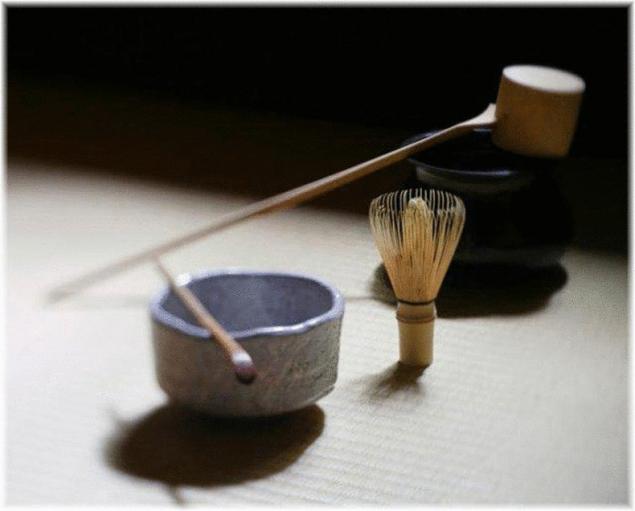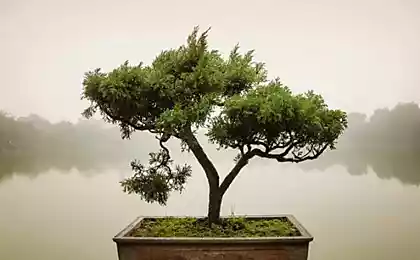573
Tea and Zen story in three cups
"The taste of Zen is like the taste of tea" (cha Zen ichi mi), said once Zen master Dayrin Soto. This phrase became famous, however unenlightened mind such a relationship hardly seems obvious. What are the similarities between refined and sophisticated Japanese art of preparing and drinking tea and ascetic-a stern philosophy of Zen Buddhism? Not one article not one scientific study devoted to finding the answer to this question. The very same tea tradition, like any other art, influenced by Zen, stingy with words and not trust to intelligent reasoning. In its space use of a special language — the language of things, who themselves have used to tell their stories.
And maybe that tea Cup (Cavan), so often carrying out important mediating role between master and apprentice, master and guest, can tell many interesting.
Temmoku, Cup 1Первые teacups, and the tea itself, appeared in Japan in the kamakura period (XII century). Of all utensils, imported Japanese monks after teaching in mainland China, emphasizes the cups temmoku (from the name of the mountain Tanya, Japanese Temmoku, where the Chan monastery). First of all, they attracted a surprisingly correct form, and unusually thick black glaze. Bezel top edge of the cups were often decorated with gold or silver.
There are several varieties temmoku, but unsurpassed in its beauty was considered — and is still! — Ehan-temmoku (temmoku "the Changing lights"), on smooth surfaces if accidentally spilled white, pale blue and dark blue spots, resembling stars in the night sky.
Gradually tea meetings and tea tournaments were the most fashionable and favorite entertainment more affluent samurai and temmoku, are also gradually moved from the category of the utensils in the object of reverence and worship. These foreign beauties have graced the collection of the military rulers of Ashikaga sorts, they boasted, they proudly put on display in front of guests, they created special rules of etiquette. And in our time, centuries later, temmoku are still No. 1 among a huge number of tea ceramics of the highest level. And still they captivate connoisseurs of art with its unattainable perfection.
Wabi, a new vision createpolyline popular among the samurai tea is also an integral part of monastic life. It was there, in the quiet of the Zen monasteries into a different vision of beauty, articulated Zen briefly in this important for Japanese aesthetics the concept of wabi. This new vision opened the inner beauty, not external, and encouraged to comprehend the "philosophy of poverty". In the poverty of the people, not being able to have a variety of things, learned to recognize the singleness and uniqueness of every object and every phenomenon. Discovering the divine essence of things, inherent in all initially, people know your true self, your true nature, which was the basis of all Zen practice. This approach demanded a special state of mind, which "prefers solitude — a large company, instantaneity — the immutability of nature — culture, poverty — wealth, individual lots, asymmetry — symmetry, imperfect — perfect".
IDO, "pit bowl""I care about the moon without clouds", said once the tea master Murata, Shuko (1422-1502), so poetically and concisely defining the new aesthetics. It is obvious that in the emerging tradition of wabi-tea didn't really fit the cosmic-Frank unattainable splendor temmoku. Much more appropriate here seemed modestly shimmering charm of Korean ceramics. So in the arena of history tea was a famous Cup of IDO, or "pit bowl". Maybe she really someone resembled a deep well (IDO in Japanese means "well") because it was of rather large size and conical shape. But the most important thing was that this Cup is amazingly conveys a sense of life itself, her free movements, like a simple Korean craftsman somehow miraculously managed to catch a unique moment and capture it in clay. Soft glaze, which shines through the rough, porous surface, a few drops, accidentally frozen at the base, jagged edges — all not talking about the perfection of skill, but about something natural and unfathomable. Very soon the Cup IDO has taken a worthy place in the collections of famous samurai.
The most famous Cup IDO named Kizaemon, named after its first owner, a few centuries passed from one noble house to another. They say that this Cup has carried a curse since every family in which she lived, was pursued by misfortune. It was not until until in 1822 the Cup is not deposited in one of the temples of the monastery Daitokuji. There she has taken a worthy place among the other temple treasures, and notoriety finally left her.
Cancer, the confrontation between the two low the end of the XVI century by master sen-no Rikyu was first created the Cup specifically for tea ceremonies. Too simple and unassuming in appearance, uncommonly modest in color (Cup Cancer are only black and dusky red color), it was like she was transformed in the hands of man, and anyone who touched her, felt her living warmth. The first Cup of sen-no rikyū was a stain, awarded a military ruler Hideyoshi, with the character Raku, "enjoyment".
The shogun Hideyoshi was a passionate admirer of the art of tea. He arranged an unprecedented scale tea meeting, on his orders were built a Golden tea room. It is not surprising that black Cup Cancer is not like a famous samurai. Their almost monastic austerity annoyed him, and it was known to all, but every time he visited his personal tea master Rikyu, he set before him a black Cancer, bringing irascible Hideyoshi almost to rabies. Perhaps this was one of the reasons for the death of the great master, who by order of his master was forced to commit ritual suicide. A Cup Cancer live today. The master of the house Cancer already in the 15th generation to create their masterpieces for all who follow the traditions of wabi tea, and the teachings of sen no Rikyu.
In the Japanese tea tradition, the cups are as living beings. They have their own unique faces, names, stories that are passed from mouth to mouth and from heart to heart. To find them, you just need to take the tea Cup in his hands. Because, as he wrote the famous Explorer and interpreter of Zen Buddhism to Daisetsu Suzuki, "everyone must, at least once in life to experience direct contact with spiritual beauty".
Elena Nesterova
source:http://newacropolis.ru
Source: /users/1077

And maybe that tea Cup (Cavan), so often carrying out important mediating role between master and apprentice, master and guest, can tell many interesting.
Temmoku, Cup 1Первые teacups, and the tea itself, appeared in Japan in the kamakura period (XII century). Of all utensils, imported Japanese monks after teaching in mainland China, emphasizes the cups temmoku (from the name of the mountain Tanya, Japanese Temmoku, where the Chan monastery). First of all, they attracted a surprisingly correct form, and unusually thick black glaze. Bezel top edge of the cups were often decorated with gold or silver.
There are several varieties temmoku, but unsurpassed in its beauty was considered — and is still! — Ehan-temmoku (temmoku "the Changing lights"), on smooth surfaces if accidentally spilled white, pale blue and dark blue spots, resembling stars in the night sky.
Gradually tea meetings and tea tournaments were the most fashionable and favorite entertainment more affluent samurai and temmoku, are also gradually moved from the category of the utensils in the object of reverence and worship. These foreign beauties have graced the collection of the military rulers of Ashikaga sorts, they boasted, they proudly put on display in front of guests, they created special rules of etiquette. And in our time, centuries later, temmoku are still No. 1 among a huge number of tea ceramics of the highest level. And still they captivate connoisseurs of art with its unattainable perfection.
Wabi, a new vision createpolyline popular among the samurai tea is also an integral part of monastic life. It was there, in the quiet of the Zen monasteries into a different vision of beauty, articulated Zen briefly in this important for Japanese aesthetics the concept of wabi. This new vision opened the inner beauty, not external, and encouraged to comprehend the "philosophy of poverty". In the poverty of the people, not being able to have a variety of things, learned to recognize the singleness and uniqueness of every object and every phenomenon. Discovering the divine essence of things, inherent in all initially, people know your true self, your true nature, which was the basis of all Zen practice. This approach demanded a special state of mind, which "prefers solitude — a large company, instantaneity — the immutability of nature — culture, poverty — wealth, individual lots, asymmetry — symmetry, imperfect — perfect".
IDO, "pit bowl""I care about the moon without clouds", said once the tea master Murata, Shuko (1422-1502), so poetically and concisely defining the new aesthetics. It is obvious that in the emerging tradition of wabi-tea didn't really fit the cosmic-Frank unattainable splendor temmoku. Much more appropriate here seemed modestly shimmering charm of Korean ceramics. So in the arena of history tea was a famous Cup of IDO, or "pit bowl". Maybe she really someone resembled a deep well (IDO in Japanese means "well") because it was of rather large size and conical shape. But the most important thing was that this Cup is amazingly conveys a sense of life itself, her free movements, like a simple Korean craftsman somehow miraculously managed to catch a unique moment and capture it in clay. Soft glaze, which shines through the rough, porous surface, a few drops, accidentally frozen at the base, jagged edges — all not talking about the perfection of skill, but about something natural and unfathomable. Very soon the Cup IDO has taken a worthy place in the collections of famous samurai.
The most famous Cup IDO named Kizaemon, named after its first owner, a few centuries passed from one noble house to another. They say that this Cup has carried a curse since every family in which she lived, was pursued by misfortune. It was not until until in 1822 the Cup is not deposited in one of the temples of the monastery Daitokuji. There she has taken a worthy place among the other temple treasures, and notoriety finally left her.
Cancer, the confrontation between the two low the end of the XVI century by master sen-no Rikyu was first created the Cup specifically for tea ceremonies. Too simple and unassuming in appearance, uncommonly modest in color (Cup Cancer are only black and dusky red color), it was like she was transformed in the hands of man, and anyone who touched her, felt her living warmth. The first Cup of sen-no rikyū was a stain, awarded a military ruler Hideyoshi, with the character Raku, "enjoyment".
The shogun Hideyoshi was a passionate admirer of the art of tea. He arranged an unprecedented scale tea meeting, on his orders were built a Golden tea room. It is not surprising that black Cup Cancer is not like a famous samurai. Their almost monastic austerity annoyed him, and it was known to all, but every time he visited his personal tea master Rikyu, he set before him a black Cancer, bringing irascible Hideyoshi almost to rabies. Perhaps this was one of the reasons for the death of the great master, who by order of his master was forced to commit ritual suicide. A Cup Cancer live today. The master of the house Cancer already in the 15th generation to create their masterpieces for all who follow the traditions of wabi tea, and the teachings of sen no Rikyu.
In the Japanese tea tradition, the cups are as living beings. They have their own unique faces, names, stories that are passed from mouth to mouth and from heart to heart. To find them, you just need to take the tea Cup in his hands. Because, as he wrote the famous Explorer and interpreter of Zen Buddhism to Daisetsu Suzuki, "everyone must, at least once in life to experience direct contact with spiritual beauty".
Elena Nesterova
source:http://newacropolis.ru
Source: /users/1077























